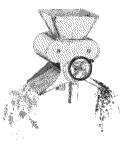Red wine making

White wine making
White wines are produced with white grapes and with red grapes which contain white juice.
Making white wine differs from making red wines in five principal ways :
- There is not or very little maceration (a few hours on juices derived from white grapes with white juice)
- Pressing precedes fermentation
- Temperatures of fermentation are lower (around 20░C)
- Alcoholic fermentation takes place with clear juice (the must undergoes a racking: decanting removes solid materials or mud and fine dregs.
- Malolactic fermentation is controlled so as preserve acidity and freshness.
RosÚ wine
Making RosÚ is the same as far white wines when applied to the grapes with red film. The duration of maceration influences the final colour of the wine.
Grape harvest
The moment chosen for haversting the grape is important in helping to determine the quality of the wine.
The maturation of the grape is followed with great care and it is harvested only when it reaches the equilibrium sugar content - acidity given. Grapes are harvested by teams of pickers. The grapes are then transported in boxes or containers to the cave. Specialised machinery is increasingly used to harvest the grapes in those vineyards where the vines are easily accessible.
Pressing
Pressing consists of crushing the grapes without crushing the pips and stem. The maximum amount of juice is released which when put in contact with yeast and must and then aerated enables fermentation to commence.
The destalking:
Stem is separated from the rest of the grape harvest. The elimination, as far possible, of the stem and its tannins results in less astringent wines.
Fermentation
It takes between two to three weeks in Languedoc Roussillon. Two simultaneous operations take place during this phase.
The maceration :
The substances contained in the film dissolve in the juice. Decomposition is aided by the alcohol contained in the mix and by elevated temperatures.
Alcoholic fermentation: The alcoholic fermentation, thanks to yeasts contained in the juice, transforms sugars into alcohol. During this transformation, some carbon dioxide (CO2) is released. The optimal temperature of red wine making is between 28 to 30░C. Yeasts can not work at temperature above 35 ░. The winemaker regularly (up to twice a day) pushes down the solid particles which rise up to the top of the must (the cap). He "pigeages" the mix so as to extract colour and improve tannins.
Pressing
When the fermentation is finished the wine is separated by drainage from solid matter, the "marc" rich in wine is sent to the press-wine. The classical press-wine with trays (2 open-work trays compressed together) is increasingly being replaced by the pneumatic wine press (balloon inflated with air in a stainless steel cylinder). Free run wine and pressed wine are assembled in the proportions desired by the wine grower.
Maturing
After alcoholic fermentation the wine, which is shady and with a high carbon dioxide content, is subject to a primary decanting which is designed to aerate and cleanse it.
The wine which is stored in tubs or more frequently in wooden barrels of 220 litres undergoes a further transformation, malolactic fermentation, which is the work of lactic bacteria. These attack acids, the young wine loses its acerbic and hard character, and becomes more supple. Maturity can take between 6 to 18 months according to the type of wine required. It is accompanied during the first months by regular racking. At the same time the wine grower makes sure that the barrels are kept replenished to allow for a small amount of evaporation through the surface of the barrel. Refilling the barrels, known as topping-up is carried out weekly.
Bottling
When the wine is sufficiently mature, the wine is struck and cleansed by means of products floculants such as egg white.
It is filtered with filters or with membranes so as to optimise stability and limpidity. The bottling, carried out in the domains and chateaux, is a guarantee of the authenticity of the wines.








